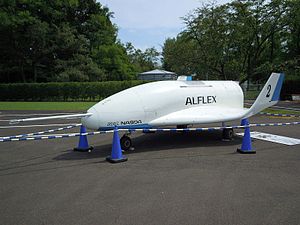ALFLEX (Automatic Landing Flight EXperiment) was an experimental unmanned aircraft created by NASDA and NAL, the predecessors of JAXA, in 1996. It was built as a successor to HYFLEX as part of the HOPE program.[1]

ALFLEX was built to establish the basic technology of automatic landing. The design featured a streamlined metal hull, delta planiform wings, and large winglets. Despite being a project of Japanese aerospace agencies, ALFLEX never left the atmosphere. Instead, it was carried up to a high altitude by a helicopter, then released to automatically glide down to the designated landing site, navigating by means of onboard computers.[2] ALFLEX completed thirteen drop tests from July to August 1996, all of which were successful.[3]
Specifications (ALFLEX)
editSee also
editReferences
edit- ^ "About Automatic Landing Flight Experiment "ALFLEX"". JAXA. Retrieved July 4, 2023.
- ^ Taro Tsukamoto; Masaaki Yanagihara; Masahiko Nagayasu; Masakazu Sagisaka (1997). "ALFLEX five degrees of freedom hanging flight test". 22nd Atmospheric Flight Mechanics Conference. doi:10.2514/6.1997-3484. Retrieved July 4, 2023.
- ^ "NASDA History". NASDA. Retrieved July 4, 2023.
Automatic Landing Flight Exepriment (ALFLEX) was conducted 13 times.
- ^ a b c "ALFLEX". astronautix.com. Archived from the original on December 28, 2016.
External links
edit